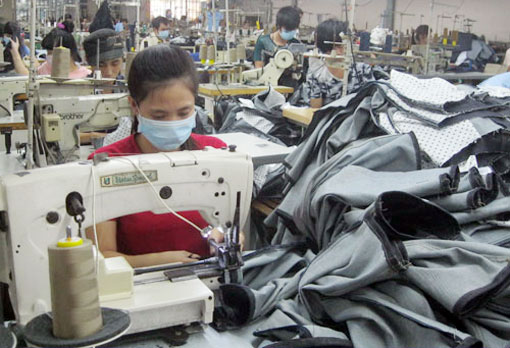To be adapted for development
At the seminar themed "Southeast region with international integration and sustainable development" hosted by Ministry of Foreign Affairs in collaboration with Binh Duong province People's Committee, Mr. Tran Ngoc An, Director of Multilateral Economic Cooperation Department (Ministry of Foreign Affairs), shared that the global economy was in the growth phase of decline. In addition to the US as No. 1 economically power, China was ranked 2nd, generating large quantities of goods in all areas, making the competition in regional scale fiercer.

Binh Duong's textile industry is having great opportunities and even many challenges, when the signed FTAs take effect. Photo: A production line at Dai Tay Duong Garment Company (Dong An Industrial Park, Thuan An Town)
Technology is changing the global economy
Experts said that the world economy was recovering slowly, predicted in 2016 global trade growth would be only 2.6%. Correlations among major countries are rapidly changing, the order of the world and Asia - Pacific seems to be reorganized. This area has become the most influential among developed countries. Besides, countries tend to develop innovative thinking, economic restructuring to find the optimal growth model ensuring a sustainable development.
Meanwhile, the knowledge economy, green economy, e-commerce are increasingly being taken seriously, so our country has to reform and take concrete actions to restructure the economy; enhance competitiveness, boost auxiliary industries, reduce sustainably poverty and ensure environmental protection. According to Mr. Truong Dinh Tuyen, former Minister of Commerce, the rapid growth of scientific and technological initiatives has created a mass of material wealth and spiritual products. Meanwhile, the division of labor has become deeper, stimulating liberalization of trade and investment in order for elements of the reproduction process to move freely on a global scale, leading to the trend of economic globalization and liberalization of trade, services and investment in terms of forms and expressions. This process has shortened the industrialization process; countries and enterprises could soon overtake those developed countries, if they planed right strategies. On the other hand, the uncertainty of risks also increases, due to the process of liberalization, the rapid growth of financial markets, and derivative products; thus the fluctuation of an economy could affect heavily on a global scale.
Ms. Pham Chi Lan, former Vice Chairwoman of Vietnam Chamber of Commerce and Industry (VCCI), said that new technologies had changed the overall global economy, causing more risks to labor-intensive enterprises. Today, wind, solar, geothermal power... are developing at a high speed; the e-commerce development helps reduce information costs, change traditional business modes. Regarding artificial intelligence, robots can replace people and perform dangerous works requiring a lot of effort, thereby also facilitating the introduction of new products...
Appropriate auxiliary industries to be developed
TPP is considered as a great opportunity for the whole textile industry. Currently, the average tax rate of Vietnam textiles to the US market is 17.5%, to European Union (EU) is 9.6%. Once the TPP takes effect, this tax rate will be reduced to 0%. This will be a new boost to the growth of this industry in terms of quantity and quality. Another important thing is that the textile industry’s development will increase job creation and contribute to solving the labor problem, especially in rural areas.
Ms. Nguyen Thi Tuyet Mai, Deputy Secretary-General of Vietnam Textile and Apparel Association, asserted that the TPP would open up new markets, reduce our dependence on the Chinese market. TPP would also help businesses to access capital, equipment, advanced production technology, management experiences and skilled labor from developed countries. Besides, TPP is also expected to increase FDI capital to our country, heightening competitiveness of the domestic textile industry. TPP will also stimulate institutional reforms to create a fair and transparent competitive environment. In fact, currently, under the direction of the Government, ministries, departments and localities are reviewing and amending regulations, policies, administrative procedures that are hampering business activities to gradually remove difficulties of enterprises, and boost export - import...
Ms Mai said, besides these advantages, TPP posed many challenges to textile enterprises of Binh Duong in particular and the country in general. For example, according to the TPP, most raw materials of textile industry must originate from member countries of TPP to be eligible for preferential tax rates, whereas most raw materials (about 80%) of domestic textile enterprises do not come from TPP member countries. Meanwhile, domestic auxiliary industries are still weak; materials of enterprises are mainly imported...
At present, we have a new wave of FDI into Vietnam in the field of textile; Binh Duong is one of the most attractive localities to FDI. The concern is that foreign enterprises investing in Vietnam have been quicker and surpassed domestic firms in the export race and taking advantage of new opportunities. This is a problem that textile enterprises across the country and in Binh Duong must be soon adapted to survive, develop and expand market share.
Currently, the trend of free trade is very popular in the world through multilateral and bilateral Free Trade Agreements (FTAs). In Vietnam, the TPP contains many opportunities and challenges. Mr. Truong Dinh Tuyen, former Minister of Commerce, said the TPP interested in supporting capacity building for all members to make commitments and take advantage of opportunities. TPP respects political institutions of each country, acknowledges the requirement of full compliance with national legislation in line with commitment contents, and has certain flexibility in the implementation of commitments consistent with the development level of member countries.
Reported by Phung Hieu – Translated by Ngoc Huynh

